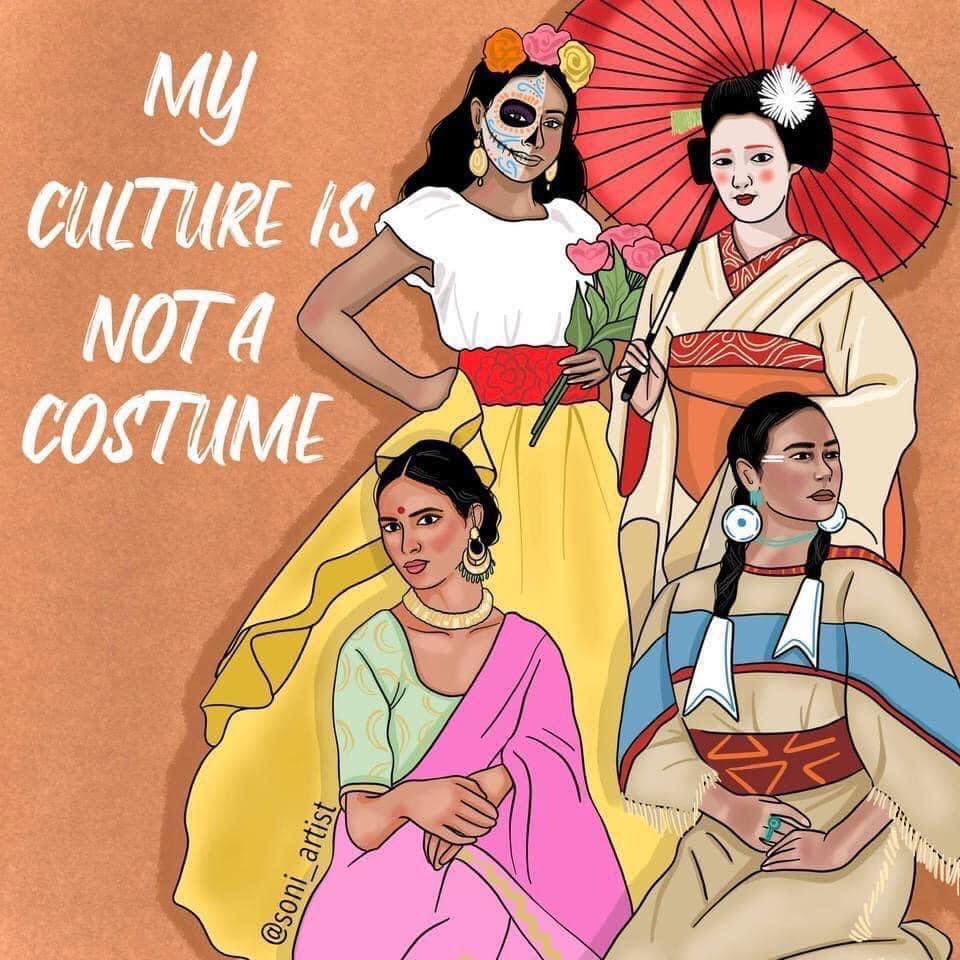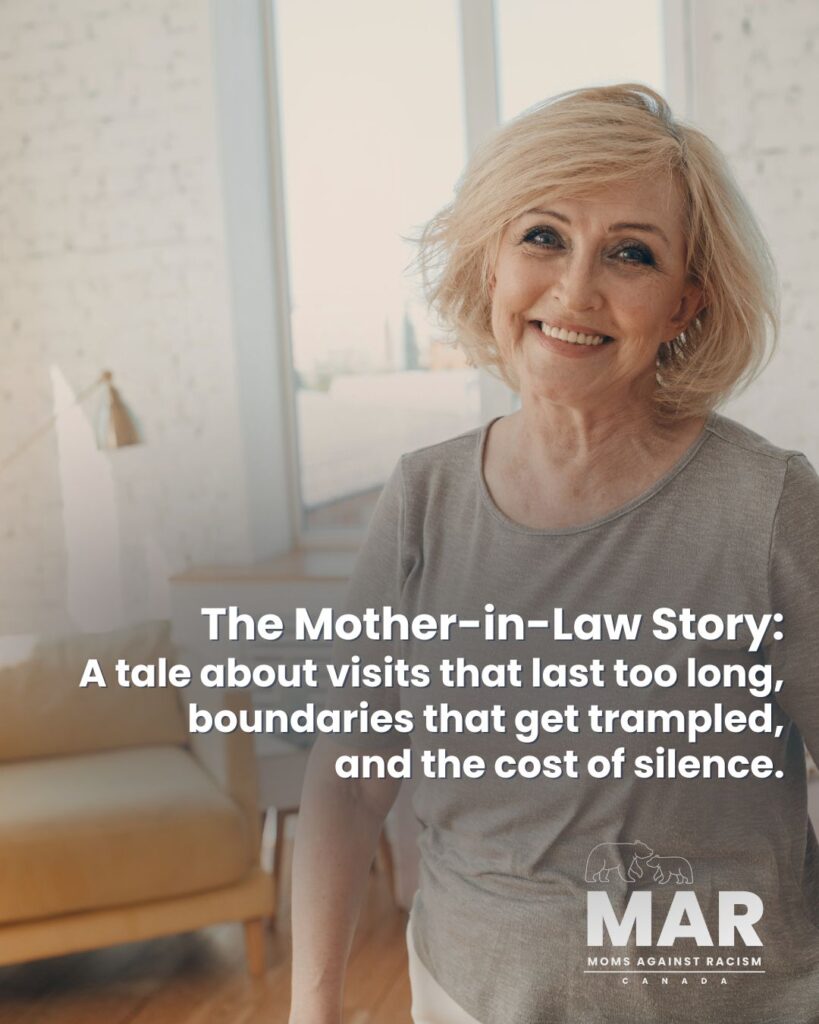Costumes vs. Cultures: A Guide for Parents


(Hint: It’s about power, not taste.)
October is a time when many racialized folks brace for harm as we approach Halloween and the season when cultures so easily become costumes. So with that, now is the perfect time to pause and ask what “appreciation” really means.
In the online mom’s groups there is often the question posed “Is it okay for my kid to wear this costume? (aka Is this costume appreciation or appropriation?)”. Over the years, I am heartened to read more and more moms stand up to cultural appropriation, but unfortunately there are still too many disappointing responses condoning appropriation and protecting privileged comfort.
So here’s some knowledge to equip yourself with to feel more confident calling people in, along with some things you can say in response to some common arguments.
My Culture is Not a Costume artwork by Soni Lopez-Chavez (@soni_artist). You can view their other artwork and purchase hoodies, t-shirts, stickers and download free colouring pages on their website.
How to tell if it is Cultural Appropriation
Sharing culture is a beautiful exchange and one that we wholeheartedly support. However, a lot of what we might refer to as “sharing” culture is actually “stealing” culture. We hosted a whole hour and a half workshop about cultural appropriation earlier this month as there is much to discuss, but we will do our best to distill it here for you.
At MAR, when talking appropriation vs appreciation, we come back to one guiding principle: look at power, not just preference.
To figure out if something crosses the line into appropriation, ask three quick questions:
- Who has systemic power in this setting?
- Has this item or practice ever been mocked, banned, or punished when used by its own people?
- Are the people of that culture systemically powerless here? Do they have fewer rights, less safety, fewer chances?
If the answers tilt toward “the dominant group holds the power”, “the item/practice’s been weaponized”, and “the cultural group of origin lacks safety”, you’re likely looking at appropriation, not appreciation.
It’s Not Only About Money
Most people understand “it’s appropriation if you financially profit”, but benefit shows up in more ways than cash. Think about who gains status, opportunity, or peace of mind from using it.
- Social/Status: When locs are called “unprofessional” on Black people but “edgy” on white celebs.
- Academic/Career: Teaching classroom content drawn from Black, Indigenous, or Global Majority scholars while only citing white secondary sources (e.g. Maslow’s Hierarchy of Needs)
- Wellness/Spiritual: When “sage smudge kits” are sold while Indigenous ceremony remains restricted or stolen.
If one group gets praise, grades, bookings, or calm while the cultural of origin still gets punished or policed, that’s a power red flag.
Answering the Common Refrains
“Culture is meant to be shared.”
Yes! But with consent, mutual benefit, and some balance of power. Sharing without those becomes stealing. Ask: Who can safely say no? Who benefits if they say yes?
Possible responses:
- “I totally agree that sharing culture is beautiful but it has to come with consent and mutual benefit. Otherwise, it slips into taking.”
- “Yes, culture can be shared, but not everything is ours to share. I try to ask, ‘Who gets to say no?’ and ‘Who benefits if they say yes?’ That helps me see if it’s sharing or stealing.”
- “I love cultural exchange too. The difference is whether both sides have power and choice. If one group risks harm for saying no, that’s not true sharing.”
“I’m not hurting anyone.”
Harm isn’t only physical. If the origin community is shamed or punished for the same thing that earns someone else praise, the harm is erasure and unequal treatment.
Possible responses:
- “It might not feel harmful, but harm isn’t only physical. If the people it comes from are punished or shamed for doing the same thing, that’s harm through double standards.”
- “I used to think that too, until I learned that when something sacred or meaningful is taken out of context, it can erase the people it belongs to. That’s a quieter kind of hurt.”
- “Even if no one’s bleeding, harm can still happen through misrepresentation or unequal treatment. I try to ask, ‘Who’s being erased or overlooked by this?’”
“I’m honoring it.”
Real honor looks like relationship, credit, and boundaries. If the item has been weaponized against its people, honoring means following their lead even when that means stepping back.
Possible responses:
- “That’s a good intention. Real honor usually shows up as relationship, credit, and boundaries—like asking permission, paying respect, or citing the people it came from.”
- “Honor is a verb. It looks like giving credit, building relationship, and sometimes stepping back when we’re asked to.”
- “If something has been used against its people, honoring it means following their lead—even if that means not using it at all.”
“It’s just fashion.” / “It’s just a costume.”
Clothing and symbols are never just fabric or decoration – they carry story, identity, and history. When a culture’s regalia, hairstyle, or sacred imagery becomes a costume or trend, it strips away that meaning. What might feel like self-expression to one person can reopen wounds for another, especially when those same items have been mocked, banned, or punished in the past. Fashion becomes appropriation when it takes without context, credit, or consent, and turns identity into novelty.
Possible responses:
- “I get that it might feel like just an outfit to you, but for many people, those clothes or symbols carry history, spirituality, and sometimes trauma. When that meaning gets turned into a trend or a joke, it disrespects what it stands for.”
- “It might look like fashion to you, but for the people it comes from, that same item might have been banned, mocked, or punished. Wearing it for fun can reopen that harm.”
- “There’s a big difference between appreciating a style and turning a culture into a costume. Appreciation uplifts and credits while costumes flatten and stereotype.”
- “I used to think it was harmless too, until I realized that if someone’s identity can be worn for a night and then taken off, it’s not a costume, it’s a culture.”
Why It Feels Harmless
Power numbs perspective. People with systemic privilege are less likely to be punished, more likely to be praised, and often shielded from seeing the fallout. That comfort afforded by privilege can feel like consent, like it’s not a big deal, like it is fine – but it isn’t.
A Call-In Lines You Can Use
Gentle and invitational (for moms you know or want to keep connection with):
- “I know it can seem like just a costume, but for a lot of families, those outfits aren’t pretend. They’re tied to identity and ceremony. When [non-Indigenous or non-racialized] kids wear them, it can feel like their culture is being played with instead of respected.”
- “I totally get wanting your kid to express themselves. The tricky part is that some costumes copy sacred or cultural clothing that people were once punished or ridiculed for wearing. It sends a painful message, even if that’s not what we mean.”
- “I get that it’s cute or creative, but for the communities it comes from, it’s not a costume – it’s history, spirituality, survival. We can still celebrate creativity without borrowing someone else’s identity.”
Balanced and firm (when they’re dismissive or defensive):
- “I hear you saying it’s harmless, but that costume represents real people who have been targeted and mocked for those same clothes. It’s not about intent. It’s about the impact.”
- “If your kid can take it off at the end of the night, but another kid gets bullied for wearing it every day, that’s not equality, that’s privilege.”
- “It’s not about policing fun; it’s about teaching our kids empathy. There are so many amazing, creative options that don’t come at someone else’s expense.”
Collaborative and solution-oriented (for schools, friend groups, or community events):
- “Hey, I’ve noticed a few costumes that might cross cultural lines this year. Would you be open to finding some resources or examples we could share so families understand why it matters?”
- “Maybe we could help our kids pick costumes that celebrate characters, ideas, or stories instead of copying real cultures or characters that portray a lot of cultural elements. That way it’s still fun and expressive, but not hurtful.”
- “What if we turned this into a learning moment? It could be a chance to talk with our kids about why certain costumes aren’t okay and help them find something creative that feels just as special.”
As Halloween approaches, this isn’t about shaming anyone into choosing a different costume. It’s about sharing information that grows empathy, social responsibility, and anti-racist action. Progress over perfection: when we know better, we do better. So before we choose a costume, a classroom activity, or a “trend”, let’s ask who holds power, who benefits, and who bears the cost, then act accordingly. This is the heart of anti-racism: noticing where power flows, where harm lands, and choosing relationship and respect over imitation. Real appreciation grows from connection, consent, and community… and from the courage to change our choices.
#Halloween #CulturalAppropriation #whitesupremacy #AppreciationNotAppropriation #NotYourCostume #CulturalDiversity #CulturalHeritage #ParentingForJustice #RaiseAntiRacistKids #AntiRacismEducation #ConnectionNotConsumption #ConsentCulture #DiversityAndInclusion #RepresentationMatters #SocialJusticeParenting #InclusiveSchools #EndRacismInSchools #KnowBetterDoBetter #MomsAgainstRacism.






Thank you so much for posting, Kerry. Can I share this publicly on social media?
Also, on a related note, I contacted my kid’s school raising concerns after I read an email stating they will have “wacky hair day,” this coming week. I’m very grateful to be noticing more of these opportunities to speak up since joining MAR and having the language to actually speak up, as well as knowing where to find resources, like this one by Relando Thompkins-Jones.
https://podcast.notesfromanaspiringhumanitarian.com/parenting-while-black-a-letter-to-daycare-about-crazy-hair-day/
Thank you and all the MAR members for the support!
Yes, it’s posted publicly on the blog so please feel free to share.